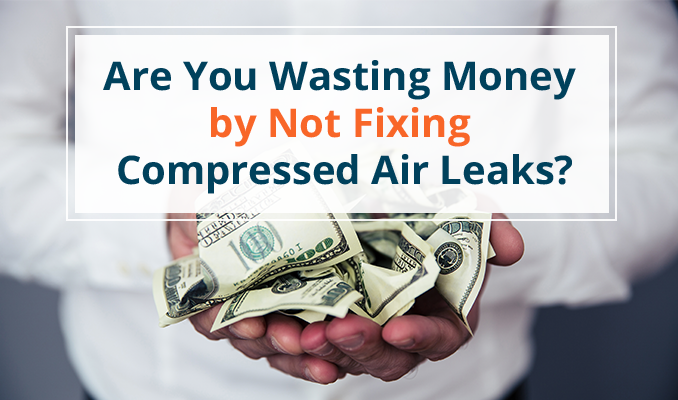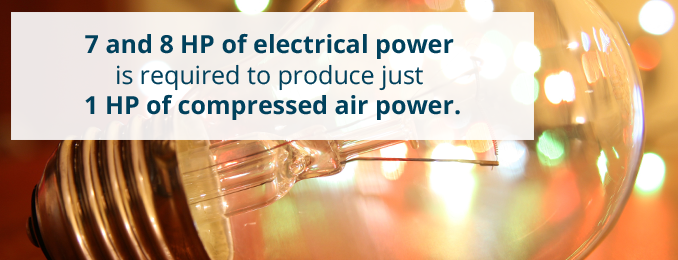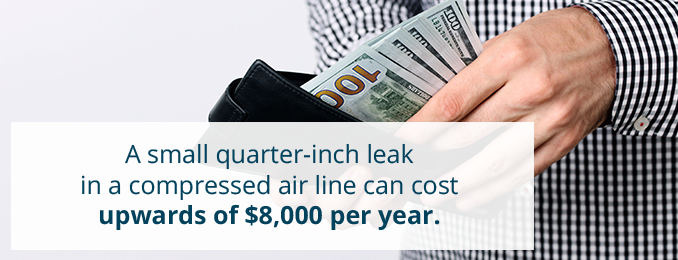
Why You Need to Fix Compressed Air Leaks
Compressed air systems are invaluable assets in a wide range of industries, and while it is often an unavoidable business expense, air leaks could be sapping more money out of your pocket in excessive energy losses every year. Even a small leak could be a detrimental financial drain to your business as compressed air is often considered one of the most expensive — and essential utilities — to many industries.
Because of its common use, cleanness, availability and ease of use, compressed air is often considered a “fourth utility” in its wide industrial use, and it is likely the most expensive utility you’ll find in your plant. Approximately 19 percent of the total power used in a compressed air system, even on a well maintained one, is converted into clean, compressed air flow. The other 81 percent is lost as heat.
It also takes a much higher amount of electrical horsepower to be converted into compressed air power. According to the average estimate, between 7 and 8 HP of electrical power is required to produce just 1 HP of compressed air power. Because of this necessary system requirement, compressed air is often more expensive than electricity, natural gas and water when it comes to costs of maintaining an operational plant.
In addition, since so much energy is required to produce the compressed air power you need, even a small leak could cause your energy prices to soar far beyond what a well-maintained and regularly inspected compressed air system would cost.
For the best performance, like most process improvement programs, compressed air leak management is vital in saving you money and operating at peak efficiency. It’s imperative for you to develop a program to routinely identify and fix leaks and to develop a trained workforce that can help you prevent future leaks.
If you’re asking yourself if even a small leak is a minor problem, consider the amount of wasted energy that is involved. Leaks place an unnecessary demand on compressed air systems. On average, a small quarter-inch leak in a compressed air line can cost upwards of $8,000 per year.
Leaks also cause the overall performance of your system to decline, ranging anywhere between a 25 percent to 50 percent waste in the system’s total output, negatively impacting pressure settings.
The True Cost of Compressed Air Leaks
When it comes to energy expenditures alone, not to mention the lower productivity and stresses placed on pneumatic tools that result from an inefficient compressed air system, fixing leaks and preventing future ones is extremely important.
For a compressed air system with a 30 percent loss of output due to leakage, consider the annual cost with a 200 HP system. If the compressor power has a total of 60 HP in leakage, it could result in an energy expense of $31,000 per year at 0.07 per KWh. As energy costs continue to rise, the expense of wasting money on repairable and avoidable air leaks becomes all the more important.
In the United States, energy waste is becoming an increased concern as estimates place a $3.2 billion expense in wasted utility payments each year due to poorly designed and maintained compressed air systems.
Why You Need to Fix Compressed Air Leaks
Even looking past the detrimental impacts air leaks might have on your annual energy expenses, leaks decrease operating efficiency and cause productivity loss due to the inevitable drop in air pressure of the system. This could result in reduced equipment life and inefficient operation of tools that rely on compressed air.
Reasons why you should fix compressed air leaks include:
- Inefficient tools and lower productivity: Drops in air pressure resulting from leaks can greatly impact the productivity of your plant by causing tools to operate inefficiently and creating an overall less-productive environment.
- Reduction in the longevity of your equipment: Because leaks cause a higher demand for air power than what is typically needed, compressors need to cycle more frequently, which can result in a decreased lifespan of your compressed air system. This could be a very expensive investment, which can be avoided through routine maintenance and inspection so leaks are identified and repaired.
- Increased maintenance expenses: Air leaks not only reduce your compressor’s longevity by putting a higher demand on the system, but leaks also likely mean more frequent repairs and maintenance expenses than if the compressor were operating at peak performance and output.
- Losses due to downtime: If your system is experiencing unnecessary demands, and maintenance is the result, you may be faced with downtime which can severely hamper productivity — and profits.
How to Detect Compressed Air Leaks and Prevent Future Problems
The first step in preventing losses for compressed air leaks can be achieved by first identifying where your problem exists and then taking steps to fix the leak. Air leaks can go undetected for years and can unfortunately lead to wasted energy expenses for a lengthy amount of time before the damage can be repaired.
Fixing compressed air leaks might seem expensive up front to some managers, but when it comes down to annual savings, maintenance investments far outweigh the cost of losing tens of thousands of dollars to wasted air flow.
Some leaks can be heard, and the easiest way to detect them is to simply walk around the compressed air system during low activity periods if possible. By scanning the area of the system, you may be able to identify if you have a leak and what assessments can be conducted following your inspection.
Unfortunately, however, not all compressed air leaks can be detected with human ears. To detect these hidden leaks, you can employ equipment like ultrasonic leak detection devices. While not as inexpensive as using your ears, ultrasonic leak detection is the best way to find leaks in your air system. It utilizes an acoustic detection device that can recognize the unique, high-frequency sounds created by compressed air leaks.
Once you identify leaks and make any necessary repairs, you’ll also want to prevent additional leaks from occurring in the future.
One way to do this is to ensure employees conduct regular leak audits with ultrasonic leak detectors. They should record the location and size of any leaks, which will help in qualifying the costs of the leakage.
If you don’t have an ultrasonic leak detector and are concerned about the cost of creating a leak management and prevention system, using a third party to conduct the audit may help justify the cost. Additionally, the cost of purchasing an ultrasonic leak detector may be justified as it will allow you do perform audits with more accuracy —thus reducing wasted energy expenses.
When searching for leaks in your compressed air systems, some specific areas might be more susceptible to leakage than others. During inspections, be extra vigilant when looking at:
- Air hoses and air hose connections or couplings
- Worn disconnects, or disconnects missing O-rings
- Filters, lubricators and regulators, if improperly installed
- Open blow-offs
- Open condensate traps
- Leaking or botched drains
- Failed or inferior quality thread sealants, or incorrectly applied thread sealants
- Control and shut-off valves
- Worn out seals or gaskets
- Old or poorly maintained pneumatic tools
- Idle or unused machine or production equipment with air input
- Inappropriate use of air, i.e. as a blower for cleaning instead of using other cleaning tools
- Using compressed air to cool cabinets such as control or electric panels
How to Determine the Magnitude of Compressed Air Leaks
To calculate how much a single leak might be costing you, you’ll need to identify both the output percentage loss and how much you’re spending on energy.
During periods of low productivity or use of your compressed air system is often the best time to conduct special testing to determine what impacts the leaks might have had.
The first step in determining how much you’re losing because of your leak is to measure the diameter and area of the leak. In addition, understanding the pressure loss is important.
One of the easiest ways to accomplish this is to conduct a load, no-load or start-and-stop testing on your compressed air system and measure the leak load. You’ll also want to record the time it takes to load and unload the compressor.
To estimate, operate the compressor in load, no-load or start-and-stop mode during a period of low activity. After recording these measurements, compare them to the compressor’s total capacity. The percentage that remains, or the total leak percentage, can then be factored into your compressor’s horsepower and used to determine just how much that percentage of output loss is costing you each year.
How to Factor in Leaks and Calculating How Much the Compressed Air System Is Costing You
When it comes to your investment, identifying how much you are currently spending on energy is an important step when factoring in how much a leak is costing you annually.
To calculate the cost of compressed air, use the following formula provided by the Compressed Air and Gas Institute:
Once you understand your typical energy requirements, factored in with the total horsepower of your compressed air system, you can identify the percentage of output loss caused by leaks and calculate your energy savings when your system is working properly.
Contact Us Learn More Find a Dealer Near You
Other Cost Effective Ways to Save on Energy Expenses
While nothing can supplement leak repair and prevention for energy savings when it comes to managing your compressed air system, some of the best solutions cost very little to nothing.
For instance, simply turning off the compressor when it is not in use or at the end of the workday, along with making sure the valves are closed when the compressor is inactive can help save you money on expenses. In addition, shifting to the correct pressure for the job and not using more than is needed can help keep your energy consumption down.
Simple steps to reduce compressed air system energy consumption include:
- Turning the system off: When the air compression system is not being utilized, turn off the equipment and help reduce the amount of energy used when it’s not needed. This could help you reduce your electric bill by up to 20 percent.
- Fixing the leaks: If you or your maintenance staff has detected leaks, don’t hesitate in getting them repaired as soon as possible. The sooner your air compression system is running at peak performance, the sooner those savings will roll in. Neglecting a problem, even a small leak, can still cost thousands of dollars every year.
- Reducing the pressure: When it comes to the operation of your air compressor, maintaining only the needed pressure to perform the job can help reduce the workload on your machinery — and the amount of energy you’re consuming to complete the task.
- Changing the filters: Like with other equipment, changing the filters frequently can help you improve system performance and can prevent pressure drops.
- Identifying and eliminating any inappropriate use of compressed air: Compressed air is an expensive utility, but by identifying which uses for the system are appropriate and which are not, you can start saving money by cutting away unnecessary tasks. Any application that can be done more effectively, or with less of a financial burden, should be chosen over the compressed air. One such example is using the high-pressure air for cooling when low-pressure air is more than suitable for the job.
- Checking for abandoned equipment: Another source of leakages can result from equipment that is not in use while is still being supplied with air flow. Check for equipment that is not in use and consider the benefits of automatic shut off valves that will close when the machine is turned off.
- Performing routine maintenance and leak prevention: Mitigating the risk for future leaks, assessing existing problems and working on a schedule to detect new problems can help you identify issues before they become too costly. Additionally, by maintaining your system’s optimal performance, you’ll ensure better overall productivity and better efficiency of your equipment and tools, ensuring you see the most for your investments.
How Quincy Compressor Can Help You
Count on Quincy Compressor to offer True Blue reliability and some of the best warranties in the industry when you need a reliable compressor to complete your tasks — no matter how large or small they may be. Our selection offers ruggedly efficient air compressors engineered to stand up to years of heavy operation.
To find a sales or service representative near you, utilize our service locator online.
At Quincy, we believe your compressor should provide you with years of hassle-free operation in the most demanding settings. We stand behind our products, which feature standard coverage for a year or more on select parts, and extended warranty options can protect your investment for up to ten years on select models.
In addition to our full line of products and services, we know that supporting our customers also means connecting them with the information they need to make smart decisions when operating, maintaining and replacing their machines. For more information on how to maintain optimal performance, and the range of services Quincy provides, please visit our Resources page.





